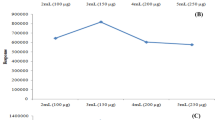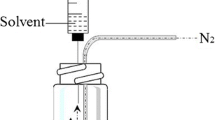Abstract
Levels of toluene and other residual solvents were evaluated in food packaging materials as a preventive action against hazard occurrence in foods via migration and to confirm food safety. Automated headspace sampling and gas chromatography/mass spectrometry (HS-GC/MS) were used to determine residual solvent levels in the food packaging materials. Correlation coefficients as calibration factors were over 0.999 and relative standard deviations (RSD) of repeatability were below 3.6%. Limits of quantification (LOQ) ranged from 0.001 to 0.01 mg/m2. The levels of 7 residual solvents including toluene for potential migration from food packaging materials to food samples were below Korean regulatory limits.
Similar content being viewed by others
References
Eilert SJ. New packaging technologies for the 21st century. Meat Sci. 71: 122–127 (2005)
Gemili S, Yemenicioglu A, Altýnkaya SA. Development of antioxidant food packaging materials with controlled release properties. J. Food Eng. 96: 325–332 (2010)
Kim HS, Gilbert SG, Johnson JB. Determination of potential migrants from commercial amber polyethylene terephthalate bottle wall. Pharm. Res. 7: 176–179 (1990)
Cutter CN. Opportunities for bio-based packaging technologies to improve the quality and safety of fresh and further processed muscle foods. Meat Sci. 74: 131–142 (2006)
Seo TK, Park SH, Lee YS, Kim JH, Kwon LB. Analysis of residual solvents in food packaging materials using solid phase microextraction method. J. Food Hyg. Saf. 14: 76–83 (1999)
Bendall JG. Food contamination with styrene dibromide via packaging migration of leachate from polystyrene cold-storage insulation. J. Food Protect. 70: 1037–1040 (2007)
Grob K, Pfenninger S, Pohl W, Laso M, Imhof D, Rieger K. European legal limits for migration from food packaging materials: 1. Food should prevail over simulants; 2. More realistic conversion from concentrations to limits per surface area. PVC cling films in contact with cheese as an example. Food Control 18: 201–210 (2007)
Sharman M, Readn WA, Castle L, Gilbert J. Levels of di-(2-ethylhexyl) phthalate and total phthalate esters in milk, cream, butter, and cheese. Food Addit. Contam. 11: 375–385 (1994)
Dopico-Garcia MS, López-Vilariño JM, González-Rodriguez MV. Determination of antioxidant migration levels from low-density polyethylene films into food stimulants. J. Chromatogr. A 1018: 53–62 (2003)
Freire MT, Santana IA, Reyes FG. Plasticizers in Brazilian food-packaging materials acquired on the retail marked. Food Addit. Contam. 23: 93–99 (2006)
Goulas AE, Zygoura P, Karatapanis A, Georgantelis D, Kontominas MG. Migration of di(2-ethylhexyl) adipate and acetyltributyl citrate plasticizers from food-grade PVC film into sweetened sesame paste (halawa tehineh): Kinetic and penetration study. Food Chem. Technol. 45: 585–591 (2007)
Lake BG, Price RJ, Cunnigham ME, Walters DG. Comparison of the effects of di(2-ethylhexyl) adipate on hepatic peroxisome proliferation and cell replication in the rat and mouse. Toxicology 123: 217–226 (1997)
Seo KW, Kim KB, Kim YJ, Choi JY, Lee KT, Choi KS. Comparison of oxidative stress and changes of xenobiotic metabolizing enzymes induced by phthalates in rats. Food Chem. Toxicol. 42: 107–114 (2004)
Dalgaard M, Hass U, Vinggaard AM, Jarkfelt K, Lam HR, Sorensen IK, Sommer HM, Ladefoged O. Di(2-ethylhexyl) adipate (DEHA) induced developmental toxicity but non antiandrogenic effects in pre- and postnatally exposed Wistar rats. Reprod. Toxicol. 17: 163–170 (2003)
Ezquerro O, Pons B, Tena MT. Headspace solid-phase microextraction-gas chromatography-mass spectrometry applied to quality control in multilayer-packaging manufacture. J. Chromatogr. A 1008: 123–128 (2003)
Ezquerro O, Pons B, Tena MT. Multiple headspace solid-phase microextraction for the quantitative determination of volatile organic compounds in multilayer packagings. J. Chromatogr. A 999: 155–164 (2003)
Kim HW, Cha IS, Kim JH, Park KM. Quantitative determination of solvents in food packaging film using headspace gas chromatography. Korean J. Food Sci. Technol. 28: 1177–1179 (1996)
Van LFS, Nijssen LM, Linssen JPH. Absorption of methanol and toluene by polyester-based bottles. Packag. Technol. Sci. 10: 221–227 (1997)
Bonini M, Errani E, Zerbinati G, Ferri E, Girotti S. Extraction and gas chromatographic evaluation of plasticizers content in food packaging films. Microchem. J. 90: 31–36 (2008)
Cho YH, Park SO, Woo SM, Hahm TS. Studies on the content of formaldehyde in food packaging paper. J. Korean Soc. Environmental. Anal. 6: 213–217 (2003)
Author information
Authors and Affiliations
Corresponding author
Rights and permissions
About this article
Cite this article
Seo, I., Shin, HS. Determination of toluene and other residual solvents in various food packaging materials by gas chromatography/mass spectrometry (GC/MS). Food Sci Biotechnol 19, 1429–1434 (2010). https://doi.org/10.1007/s10068-010-0204-x
Received:
Revised:
Accepted:
Published:
Issue Date:
DOI: https://doi.org/10.1007/s10068-010-0204-x




